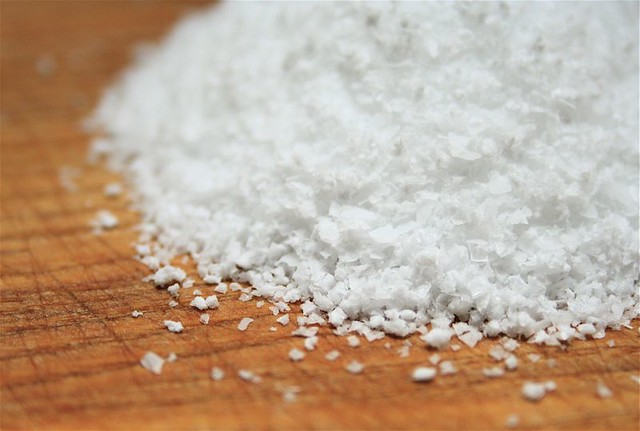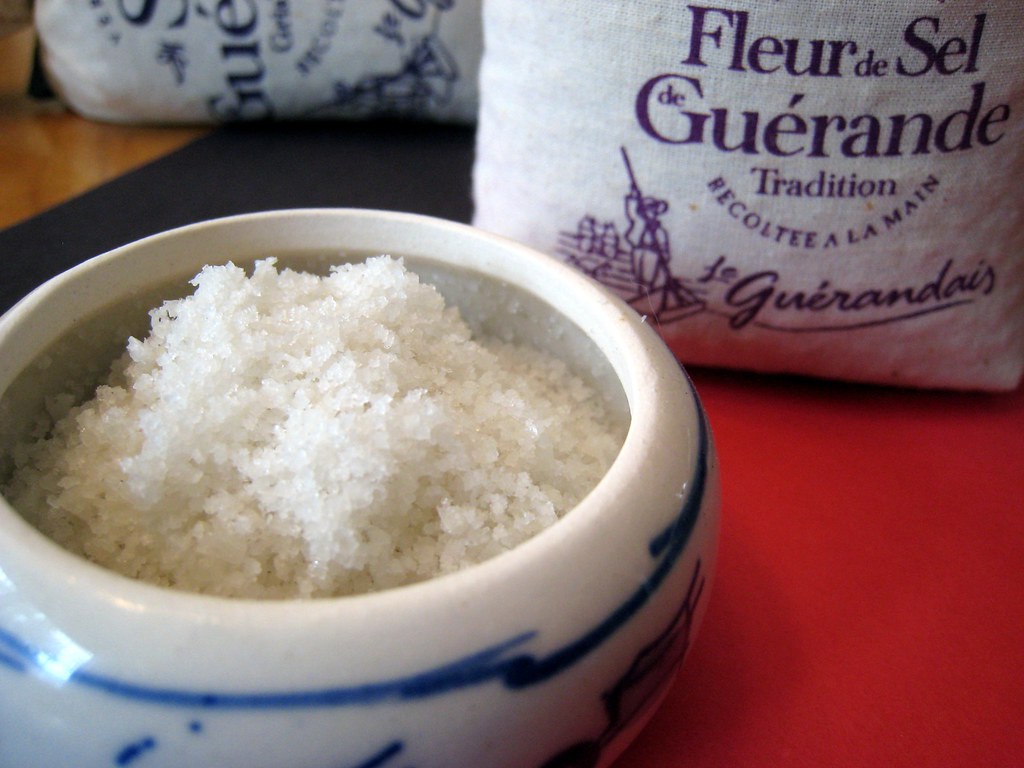It’s white. It’s black. It’s orange or even hot pink. It’s small and cubed or large and canonical. It’s in our food and in our water. It is our primary go-to flavour enhancer. But, salt is more than just flavouring. Its significance throughout history is seen in the roots of common contemporary words and sayings. The word ‘salary,’ for instance, has its root in an ancient roman word for ‘salt.’ It was tradition that Roman soldiers were paid in salt. There are more. ‘Worth their salt,’ implying a person to be good or competent in their service. Not only does it augment our flavours, but it also preserves our food. It is a chemical our body needs. It is the only natural occurring element of our basic tastes (sweet, sour, bitter, umami, and salty). It’s no wonder that it is an ingredient in nearly every recipe. It is the most basic, yet widely used kitchen staple. But, really how simple is salt when it comes in so many shapes, sizes, colours, and functions.
So, what the fuck is salt, anyway?
Basically, edible salt is sodium chloride (NaCl). Less basically, salt is a simple structure of charged ions. Much of the food we consume like proteins, fats, and carbohydrates, are complex carbon-based structures, and therefore organic materials. Salt, on the other hand, is a mineral. It is not carbon-based, and therefore inorganic. [The next time you reach for that specialty salt marked ‘organic,’ think twice. In fact, the names of salts do not reflect standards or quality, but rather how they are processed or how we are supposed to use them.]
Its chemical makeup can alter our ingredients in some pretty delicious ways. It enhances flavour compounds it accompanies, while suppressing bitter tastes.[1] Not only does it boost flavours, it also prolongs the shelf life of our food.[2] Before a time of refrigeration, salt was there to preserve our fresh food; from prosciutto to pickles, salt is still used to extend the life of our food – with delicious results.
How is it?
All salt derives from saltwater sources (ancient or contemporary). About half of the world’s salt comes from large bodies of saltwater. Essentially, ocean water is harvested and evaporated, leaving salt behind. Anywhere there was once was or still is a saltwater pool can be sourced, from landlocked lakes to ancient caves that were at one time connected to oceans. Inland saltwater springs can also be sourced. Much of our salt, however, comes from salt mines using techniques similar to coal mines.
Flake Salt
Flake salt generally refers to a salt crystal that has a fairly larger surface area because of its flatness. The most popular of these is Maldon flake salt from England. Here’s the thing, it’s actually not flat. Maldon salt crystals are conical in shape. However, flake salt has a nice crunch and great for finishing.
Granulated Table Salt
That salt shaker on your table that’s been conveniently ground for you, usually has small, regular, cubic crystals. They stack in a nice tight formation that allows for very little breathing room between crystals. It is therefore the densest in volume. Much of our good ol’ no-fuss table salt is supplemented with additives that prevent the crystals from sticking to each other.[3] Many of the anticaking agents cannot dissolved as quickly or easily as table salt. If you are not sure whether your salt crystals are sharing spaces with unwanted additives, drop some salt in some water and give ‘er a stir. If the water is cloudy, there’s a good chance your salt ain’t the purest. That, or you can just have look at the list of ingredients on the package.
Iodized Salt
Some granulated salts contain potassium iodide – a practice that began in the United Sates in 1924 to prevent iodide deficiencies. It is a nutrient that naturally occurs in salt but it removed during processing. It’s still popular practice, especially in the US, to add iodide back into the salt. Some have complained of a metallic odor when iodized salt is dissolved in water. But is otherwise pretty harmless.
Iodized salt is mostly found in granulated salt formant meant for your dinning or kitchen table. If you fear a potential iodine deficiency in your near future, iodized salt is the way to go.
Kosher Salt

As the name suggests, kosher salt was traditionally used by butchers when cleaning meat. According to Jewish dietary tradition, the blood is removed from the animal. Part of the process requires the butcher to cover the animal in a thin layer of salt. Large crystal salt was the preferred format because it could absorb more liquid and cover more surface area of the animal.
While table salt can bounce off food or roll into cracks and crevices, kosher salt tends to stick to surfaces. Kosher salt differs from table salt in that once the iodine is removed during the drying process it is not added back.
Kosher salt is favored by professionals for the majority of kitchen activities from baking to cooking to plating. However, kosher salt is not regulated and therefore its grain may change depending on the brand. That said, throwing a pinch of kosher salt into whatever you are cooking or plating is a lot easier than adding a pinch of granulated table salt. Kosher salt is larger and therefore easier to handle in your hands. Because of its compact nature, a pinch of table salt will always taste saltier than kosher.
Sea Salt – Unrefined and Otherwise
Sea salt is produced by – you guessed it – evaporated sea water. There are different variations and are labeled according to production, geography, flakiness, coarseness, grain, and size. The production of refined sea salt is similar to that of an agricultural crop: harvested when ready and then processed. However, tending salt beds can be a slow process of concentrating the seawater (and can take years). The surfaces of sea salt crystals are washed of imperfections before the drying process. However, unrefined versions are not, leaving a unique (and delicious) patina of minor minerals, algae or salt-tolerant bacteria. This gives the crystals a dusty grey hue and probably the reason the French call unrefined salts sel gris or grey salt.
Theoretically, this extra layer of terroir grit could provide a more complex flavour than refined salts. Unfortunately, that flavour would probably be overwhelmed by any food it accompanies. Compared to kosher and granulated salts, sel gris has a higher moisture content and a softer consistency. It clusters beautifully, and is ideal for plating.
Fleur de sel

William Jones, Fleur de SelHailing from the beds of France’s west coast, fleur de sel Literally translates as “flower of the salt.” Probably gained its moniker for the unique way the salt is processed. With the proper humidity and when winds are right, the salt is removed from the top of the bed before it has a chance to falls below surface – where sel gris gathers. Its flakes are fragile and is a brighter colour than its grey salt counterpart. The area between water and air is a potential party for aroma molecules, according to Harold Mcgee. So it is possible that this is where sel gris and fleur de sel could gain their flavour.
Fleur de sel has larger crystals for a more pronounced crunch. And in my humble opinion, because of its look and its price, it is better suited for last-second garnish rather than a cooking salt.
Preserving: curing and pickling salts
Once in a while you’ll come across salts intended for preserving your food, specifically curing, pickling, and/or brining.

Curing Salt via The Bitten WordCuring salts are generally hard to miss because of their bubble-gum-pink colour. Note, do not confuse this pink salt with the specialty salts of the Himalayas. Curing salts, sometimes called Prague powders (great name), get their hue from the sodium nitrite that is mixed in with table salt. These salts have generally been used on meats. Not only does the nitrite offer up a fun colour but it also slows down any chance of spoilage, specifically slowing or stopping the bacteria Clostridium botulinum (the stuff that causes botulism).
Pickling salt, or canning salt, is used specifically for – you guessed it – pickling. What makes it different from other salt types? Fair question. Not much. Pickling salt is ground finer than table salt (to reach all the nooks and crannies and free of any iodine. Which is why some professional just use kosher salt and
The others
There are other salts out there that are intended to add flavours or even just some colour. While their purpose is not entirely functional, they add great pops of colour to a dish. For instance, Hawaiian salts are beautifully black and orange. This extra colouring happens when the last chapter of salt drying is done in the lava. Unlike those precious French salts, Hawaiian salts are completely dried. Note of caution, like most of these salts, Hawaiian salts are not regulated and while it may have the right colouring and the right name, many have not gone through the lava-bed method.
Other salts include ‘seasoned’ or ‘infused’ varieties. These take on a very wide range from smoked salts to add a smoked flavour to your dish or celery salt, to add a nice touch to the rim of your next bloody Caesar/Mary. These salts aren’t necessarily of haut provenance but they are definitely plenty of fun to add to your cooking process, or better yet, your cocktails.
What is the take away? Read the labels on your salt packaging. There is technically no such thing as organic salt. When in doubt use kosher. And pickling salt seems to be a scam.
Want more? Here are some others on salt’s case:
Mark Kurlansky, Salt: a World History
Harold Mcgee, On Food and Cooking: The Science and Lore of the Kitchen and this unforgettable video.
Caitlin Penzeymoog’s great piece on Serious Eats
***Fun Fact: there is a word salt in the Turkish language. Nothing to do with sodium chloride, but, it translates as ‘absolute’ or ‘pure.’

[1] Harold Mcgee, “Sodium chloride dissolves in water into separate single atoms that carry electrical charge – positive sodium ions and negative chloride ions. These atoms are smaller and more mobile than any molecule, and therefore readily penetrate our foods, where they react in useful ways with proteins and with plant cell walls.”
[2] Mcgee, “And because a concentrated solution of any kind draws water out of living cells by osmosis – water in the less concentrated cell fluid moves out of the cell to relieve the imbalance – the presence of sufficient salt in a food discourages the growth of spoilage bacteria while allowing harmless flavor-producing (and salt-tolerant) bacteria to grow. It thus preserves the food and improves it at the same time.”
[3] Mcgee, “These additives include aluminum and silicon compounds of sodium and calcium, silicon dioxide – the material of glass and ceramics – and magnesium carbonate.” Just get a fucking salt grinder (Ikea’s are wonderful)
